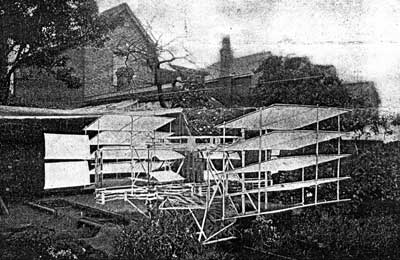

Among the many inventions relating to aerial navigation, that of Messrs. Groombridge and South, which we illustrate herewith, is worthy of consideration, from the somewhat original design of the air propellers with which it is fitted. The accompanying photographs are those of a full-sized model which has been built by the inventor, and it will be seen that the machine itself, which is about 80 feet in length and 60 feet in width, is to be supported upon superposed aeroplanes which are attached to the framework both at the front and rear of the machine, while the propellers, which are six in number, are carried three on either side of the framework. There is also an extra one, not shown in the photograph, surmounting the whole structure.

END VIEW OF THE AEROPLANE
The framework of the model is necessarily rather heavy, being constructed of wood, but in the actual finished ship a very much lighter construction would be used. The propellers are carried upon arms extending outside from the main or central driving shaft which forms an axis within a rectangle, the two vertical sides of which form axes carrying the vanes. During the driving stroke these vanes extend outside beyond the rectangle, while they return edgewise, or in a feathering position, inside it. To make this clearer, it must be understood that during the propelling stroke the vanes become strained backward against the resistance of springs, and as the vanes yield to the air, the latter remains practically normal and becomes an inert or solid fulcrum against which the vanes press, so that, when driving, they are in a vertical position, while at the completion of each stroke they automatically feather. Furthermore, the main central shaft is provided with two sets of vanes, so that one side may be propelling while the other is feathering, keeping the propulsion continuous.

MESSRS. GROOMBRIDGE AND SOUTH'S NEW AEROPLANE
There is no doubt that this new form of propeller is capable of transmitting very considerable power and the work in connection with the controlling mechanism is now so advanced that it only remains for a properly-constructed ship to be made, fitted with two 20 horsepower internal combustion engines, for a practical trial to be attempted. It must be mentioned that this airship is to be provided with four road wheels in order that it may attain a certain speed along the ground before the aeroplanes are put into action. It is estimated that when this speed has reached about twenty miles an hour the lifting power will then be sufficient to take the aerial navigator off the ground. The experiments with the new aeroplane will be followed with interest, and it is to be hoped that the machine will prove useful. The Car.
Originally appeared in Scientific American, 89, October 10, 1903, p. 262
sbck/htgb